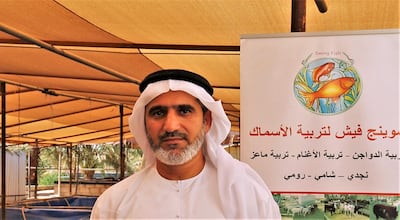The red sands of Al Ain’s sun-scorched desert have become the environment for a bizarre, symbiotic relationship between fish and watermelons.
Using integrated farming techniques, Abdulrahman Al Shamsi is growing both while using a tenth of the water and producing up to three times the yield of conventional farms.
The method has gained momentum over the past decade in the horticultural world. At its core, integrated farms try to identify and align the nutritional demands and by-products of farmable organisms.
In the case of watermelons, the fruit grows best when fertilised with nitrogen and nitrates that are the waste from, and often the environmental argument against, fish farming.
The technique has allowed the Emirati to improve his yield of goods by up to 300 per cent and reduce his water use by 90 per cent.
While leaving a small carbon footprint, Mr Al Shamsi also provides nutritious food that few traditional desert farms produce – fish.
Integrated farming is a delicate chemical balance. In some cases, it allows farmers to make use of what would otherwise be an environmental hazard, but in others the fit is extremely fruitful.
“Three times as much from date palms, just by using the wastewater from the fish farm,” Mr Al Shamsi says. “With dates, we can have three seasons of fruit.”
His technological innovation, which has prompted his peers to change their farming methods, is not limited to odd connections. Simple innovations have also yielded great results.
On his farm in Al Wagan there are no greenhouses, which have become an energy-intensive but common method of desert farming.
Mr Al Shamsi's reasoning is simple. More than half of the water used in greenhouses is for cooling. The temperatures inside can be 10°C to 20°C warmer than outside.

In a country with 50°C summers, the greenhouse is beginning to lose its prevalence. Farmers are now looking to replace them with overhead covering that can protect sensitive plants from the scorching sun.
Mr Al Shamsi’s search for new technology has taken him to farms around the world, including trips to parts of Australia that resemble the arid environments of the UAE.
He is constantly tinkering and experimenting with new concepts, calling his land “a farm and a lab”.
“I am teaching farmers,” Mr Al Shamsi said. “I want as much as I can to share my knowledge and more than 40 farms are using some of my techniques. With the support from the International Centre for Biosaline Agriculture, we will hopefully teach more.”
But with water so heavily subsidised here, it is difficult to convince some to abandoning their wasteful use of greenhouses year-round.
The International Centre for Biosaline Agriculture, based in the UAE, has been working with farmers in arid environments to help provide them with technological know-how.
Dr Ismahane Elouafi, the centre's director general, said it was farms such as Mr Al Shamsi's that provided a model for success that the centre could use to convince others to adopt more energy and water-saving methods.
“It’s a lot of information for farmers but we are here to address their needs because we need to take that data, study it and pass on what we find works,” Dr Elouafi said.
Climate change has recalibrated the challenges.
But in the Arabian Gulf it is much more urgent, with research indicating the average summer heat in the region will rise by more than the predicted 2°C global increase by 2050.
_____________
Read more:
UAE making major efforts to overcome water conservation's 'many challenges'
The growing importance of UAE food security
Amazon wins regulatory and shareholder approval for Whole Foods deal
_______________
Combined with a lack of freshwater sources and a population boom, growing food in the GCC will require methods that waste little or no resources. That will take technological advances and willingness by all to adapt.
"Some of it is technology, some of it is awareness, and we need to keep in mind water and food security," Dr Elouafi said. "In the UAE we must be more sensitive to water consumption – maybe even shift to crops that are more adaptable."
The Minister of Climate Change and Environment, Dr Thani Al Zeyoudi, said food security must be a national goal.
“Clearly, more needs to be done to ensure that the UAE is food secure into the future,” Dr Al Zeyoudi said. “We need to monitor and improve food consumption patterns and rely on innovation to develop agriculture, fisheries and livestock
He said techniques such as Mr Al Shamsi’s were crucial to the development of agriculture.
“Developing alternative sources of feed for the livestock and aquaculture industries requires establishing a programme to develop technologies to use waste streams from food supply,” Dr Al Zeyoudi said.

